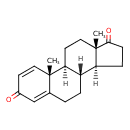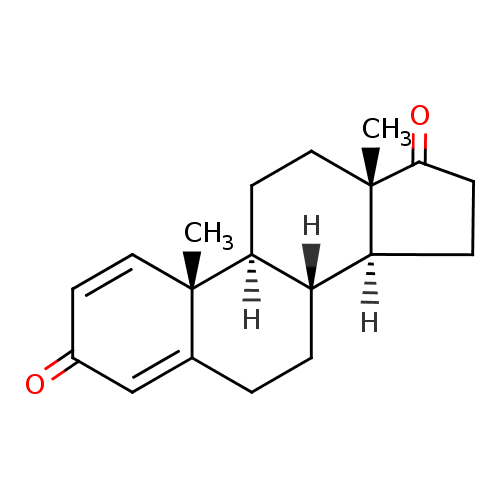|
Record Information |
|---|
| Version |
1.0 |
|---|
| Update Date |
1/22/2018 11:54:54 AM |
|---|
|
Metabolite ID | PAMDB120259 |
|---|
|
Identification |
|---|
| Name: |
androsta-1,4-diene-3,17-dione |
|---|
| Description: | A steroid that consists of androstane having double bonds at positions 1 and 4 and two keto groups at positions 3 and 17. |
|---|
|
Structure |
|
|---|
| Synonyms: | - 1,4-Androstadiene-3,17-dione
- 1-Dehydroandrostenedione
- ADD
- ADT
- androsta-1,4-diene-3,17-dione
- ANDROSTA-1,4-DIENE-3,17-DIONE
- Androstadienedione
- Boldione
|
|---|
|
Chemical Formula: |
C19H24O2 |
|---|
| Average Molecular Weight: |
284.397 |
|---|
| Monoisotopic Molecular
Weight: |
284.17764 |
|---|
| InChI Key: |
LUJVUUWNAPIQQI-QAGGRKNESA-N |
|---|
| InChI: | InChI=1S/C19H24O2/c1-18-9-7-13(20)11-12(18)3-4-14-15-5-6-17(21)19(15,2)10-8-16(14)18/h7,9,11,14-16H,3-6,8,10H2,1-2H3/t14-,15-,16-,18-,19-/m0/s1 |
|---|
| CAS
number: |
897-06-3 |
|---|
| IUPAC Name: | androsta-1,4-diene-3,17-dione |
|---|
|
Traditional IUPAC Name: |
androsta-1,4-diene-3,17-dione |
|---|
| SMILES: | CC34(C=CC(=O)C=C(CC[CH]1([CH](CCC2(C)(C(CC[CH]12)=O))3))4) |
|---|
|
Chemical Taxonomy |
|---|
|
Taxonomy Description | This compound belongs to the class of chemical entities known as androgens and derivatives. These are 3-hydroxylated C19 steroid hormones. They are known to favor the development of masculine characteristics. They also show profound effects on scalp and body hair in humans. |
|---|
|
Kingdom |
Chemical entities |
|---|
| Super Class | Organic compounds |
|---|
|
Class |
Lipids and lipid-like molecules |
|---|
| Sub Class | Steroids and steroid derivatives |
|---|
|
Direct Parent |
Androgens and derivatives |
|---|
| Alternative Parents |
|
|---|
| Substituents |
- Androgen-skeleton
- Oxosteroid
- 17-oxosteroid
- 3-oxosteroid
- 3-oxo-delta-1,4-steroid
- Delta-1,4-steroid
- Cyclic ketone
- Ketone
- Organic oxygen compound
- Organic oxide
- Hydrocarbon derivative
- Organooxygen compound
- Carbonyl group
- Aliphatic homopolycyclic compound
|
|---|
| Molecular Framework |
Aliphatic homopolycyclic compounds |
|---|
| External Descriptors |
|
|---|
|
Physical Properties |
|---|
| State: |
Solid |
|---|
| Charge: | 0 |
|---|
|
Melting point: |
Not Available |
|---|
| Experimental Properties: |
| Property | Value | Reference |
|---|
| Melting Point | Not Available | Not Available | | Boiling Point | Not Available | Not Available | | Water Solubility | Not Available | Not Available | | LogP | Not Available | Not Available |
|
|---|
| Predicted Properties |
|
|---|
|
Biological Properties |
|---|
| Cellular Locations: |
Not Available |
|---|
| Reactions: | |
|---|
|
Pathways: |
|
|---|
|
Spectra |
|---|
| Spectra: |
Not Available |
|---|
|
References |
|---|
| References: |
- Weber S, Puripattanavong J, Brecht V, Frahm AW (2000)Phytochemical investigation of Aglaia rubiginosa. Journal of natural products 63, Pubmed: 10843575
|
|---|
| Synthesis Reference: |
Brzezowska, Ewa; Kowalski, Tadeusz. Method for obtaining androsta-1,4-diene-3,17-dione. Pol. (2007), 4pp. |
|---|
| Material Safety Data Sheet (MSDS) |
Download (PDF) |
|---|
|
Links |
|---|
| External Links: |
|
|---|


